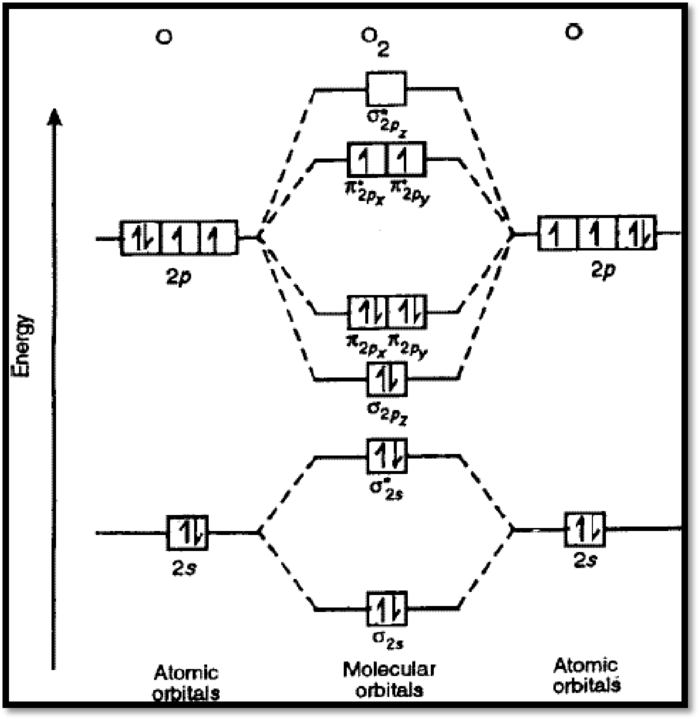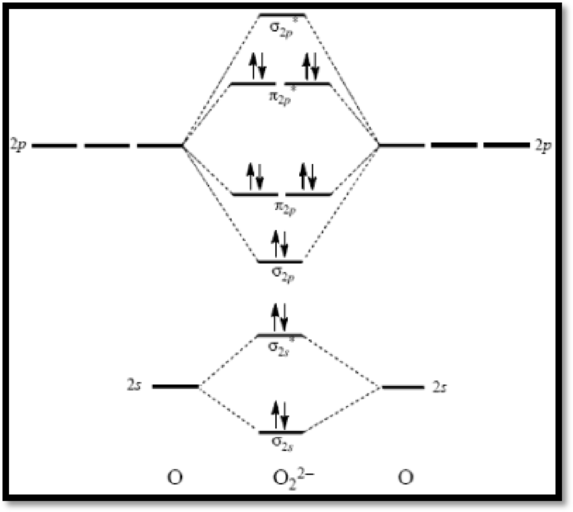
Concept explainers
(a)
Interpretation:
The molecular orbital diagram of
(a)
Explanation of Solution
The electronic configuration is,
The molecular orbital diagram of

Figure 1
The bond order of
The bond order of
The magnetic nature of
(b)
Interpretation:
The molecular property of oxygen that is explained by its molecular orbital diagram but not by Lewis structure has to be given.
(b)
Explanation of Solution
The molecular property of oxygen that is explained by its molecular orbital diagram is magnetic property.
The Lewis structure of oxygen is,

From the Lewis structure, it can be seen that all electrons are paired, and it is diamagnetic in nature. However, the molecular orbital diagram of oxygen (figure 1) shows the presence of two unpaired electrons and therefore, oxygen is paramagnetic.
(c)
Interpretation:
The nature of highest occupied molecular orbital in oxygen has to be given.
(c)
Explanation of Solution
The electronic configuration of oxygen in the ground state is
(d)
Interpretation:
The bond order and magnetic property in peroxide ion and superoxide ion has to be given.
(d)
Explanation of Solution
The formula of peroxide ion is
The formula of superoxide ion is
Superoxide ion
The molecular orbital diagram of

Figure 2
The bond order of
Superoxide ion
Peroxide ion
The molecular orbital diagram of

Figure 3
The bond order of
Peroxide ion
Want to see more full solutions like this?
Chapter 8 Solutions
Chemical Principles: The Quest for Insight
- What is the final product when hexanedioic acid reacts with 1º PCl5 and 2º NH3.arrow_forwardWhat is the final product when D-galactose reacts with hydroxylamine?arrow_forwardIndicate the formula of the product obtained by reacting methyl 5-chloro-5-oxopentanoate with 1 mole of 4-penten-1-ylmagnesium bromide.arrow_forward
- The temperature on a sample of pure X held at 1.25 atm and -54. °C is increased until the sample boils. The temperature is then held constant and the pressure is decreased by 0.42 atm. On the phase diagram below draw a path that shows this set of changes. pressure (atm) 2 0 0 200 400 temperature (K) Xarrow_forwardQUESTION: Answer Question 5: 'Calculating standard error of regression' STEP 1 by filling in all the empty green boxes *The values are all provided in the photo attached*arrow_forwardpressure (atm) 3 The pressure on a sample of pure X held at 47. °C and 0.88 atm is increased until the sample condenses. The pressure is then held constant and the temperature is decreased by 82. °C. On the phase diagram below draw a path that shows this set of changes. 0 0 200 temperature (K) 400 аarrow_forward
 Chemistry: Principles and PracticeChemistryISBN:9780534420123Author:Daniel L. Reger, Scott R. Goode, David W. Ball, Edward MercerPublisher:Cengage Learning
Chemistry: Principles and PracticeChemistryISBN:9780534420123Author:Daniel L. Reger, Scott R. Goode, David W. Ball, Edward MercerPublisher:Cengage Learning Chemistry by OpenStax (2015-05-04)ChemistryISBN:9781938168390Author:Klaus Theopold, Richard H Langley, Paul Flowers, William R. Robinson, Mark BlaserPublisher:OpenStax
Chemistry by OpenStax (2015-05-04)ChemistryISBN:9781938168390Author:Klaus Theopold, Richard H Langley, Paul Flowers, William R. Robinson, Mark BlaserPublisher:OpenStax

